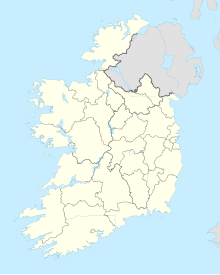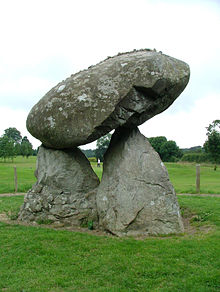Proleek
Coordinates: 54 ° 2 ′ 14.1 ″ N , 6 ° 20 ′ 52.3 ″ W.
Proleek (also Giant's Grave , German "Riesengrab" or Giant's Load , German "Gigantenlast" ) is an approximately 3.8 m high portal tomb in the townland of Proleek ( Irish Proilíg ) on the Cooley Peninsula in County Louth in Ireland . J. Fergusson (1808–1886) coined the term “tripod dolmen” for this subspecies, which is applied to a series of dolmens in which the capstone rests on three bearing stones. In the Proleek system, only two of the three load-bearing stones and the cap stone were left, the third stone was added. Systems of this type emerged around 3000 BC. Chr.
The Tomb portal
The dolmen has been depicted many times. As early as 1742 an engraving appeared in the magazine "Louthiana" by the antiquarian Thomas Wright. In a way, the dolmen resembles a figure bent under the weight of the 40-tonne, 3.8 m long and 3.2 m wide granite of the capstone. Wright tells the following story of the locals about the dolmen: The stones were brought from the neighboring mountains by Parrah Boug M'Shagjean ( Para Buidhe Mór Mhac Seóidin ), a giant who is said to be buried nearby, and collected here. However, unlike other contemporary antique collectors, Wright knew the purpose of the monuments and also dismissed the idea that they were supposed to have been altars of the Druids as a fantasy.
Visitors to Proleek will notice that pebbles lie on the convex surface of the capstone. Legend has it that whoever manages to position his stone on the surface will marry within a year.
Ballykeel in County Armagh and Legananny in County Down (all in Northern Ireland) are similarly impressive .
The Wedge Tomb
Wedge Tombs (German: " Wedge Graves", formerly also called "wedge-shaped gallery grave") are aisle-less, mostly undivided megalithic buildings from the late Neolithic and early Bronze Age . Proleek Portal Tomb is 80 meters from a restored Wedge Tomb on the grounds of the Ballymascanlon Hotel. The gallery is about six meters long and at the western end (access side) 1.5 m wide. It narrows to just over a meter at the eastern end, which is covered by the only two remaining capstones. At the western end there is a large plate that closed the gallery.
See also
literature
- James Fergusson: Rude Stone Monuments. In all countries their age and uses. Murray, London 1872.
- Kenneth McNally: Standing Stones and other monuments of early Ireland . Appletree, Belfast 1984, ISBN 0-86281-121-X .
- Peter Harbison : Guide to the National Monuments in the Republic of Ireland. Gill and Macmillan, Dublin 1992, ISBN 0-7171-1956-4 , p. 166.
Web links
- Description in English and pictures (last accessed on December 7, 2012)
- Brief description and pictures of both systems (last accessed on December 7, 2012)
- Description Wedge Tomb English and picture

